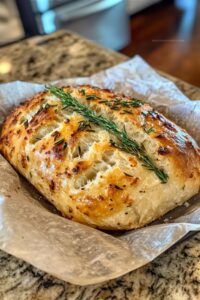Description
Rustic no-knead rosemary garlic bread delivers a soul-warming Mediterranean embrace with minimal effort. Crusty exterior and pillowy interior invite bread enthusiasts to savor each aromatic slice that whispers comfort and simplicity.
Ingredients
Scale
Main Ingredients:
- 3 cups all-purpose flour
- 1.5 teaspoons (7.5 grams) salt
- 0.25 teaspoons (1.25 grams) active dry yeast
- 1.5 cups (360 milliliters) water
Flavor Enhancers:
- 2 tablespoons fresh rosemary, chopped
- 3 cloves garlic, minced
Optional Garnish:
- 1 tablespoon olive oil (for brushing)
Instructions
- Create a loose dough mixture by whisking flour, salt, and yeast together in a spacious vessel. Incorporate finely chopped rosemary and minced garlic, ensuring even distribution throughout the dry ingredients.
- Pour warm water and olive oil into the flour mixture, stirring with a wooden spoon until a shaggy, sticky texture emerges. Ensure no dry flour pockets remain in the developing dough.
- Cover the bowl completely with plastic wrap and let the mixture ferment at ambient temperature for 12-18 hours. During this extended resting period, wild yeast will develop complex flavors and create numerous air bubbles.
- When fermentation completes, sprinkle flour across a clean work surface. Gently turn out the bubbly dough, handling it delicately to preserve the intricate air pockets that provide the bread’s signature texture.
- Softly shape the dough into a rustic round loaf, using minimal manipulation to maintain its airy structure. Transfer the formed loaf onto a parchment paper surface.
- Allow the shaped dough to undergo a secondary proofing for 30-40 minutes, giving it time to relax and slightly expand. Simultaneously, position a Dutch oven inside the oven and preheat to 450°F (230°C).
- Carefully slide the parchment paper with dough into the scorching hot Dutch oven. Cover and bake for 30 minutes, creating steam that helps develop a crisp exterior.
- Remove the lid and continue baking for an additional 10-15 minutes until the crust transforms into a gorgeous golden-brown color with a crackling surface.
- Remove the bread from the oven and transfer to a cooling rack. Let it rest for 10-15 minutes, allowing internal moisture to redistribute and structure to set before slicing.
Notes
- Elevate the bread’s flavor by toasting fresh rosemary and minced garlic before adding them to the dough for a deeper, more complex taste profile.
- Experiment with different flour types like whole wheat or spelt for varied textures and nutritional benefits, ensuring the hydration levels remain consistent.
- For gluten-sensitive individuals, substitute regular flour with a high-quality gluten-free blend, adding xanthan gum to help maintain the bread’s structure and rise.
- Create a crispy, professional-looking crust by scoring the top of the dough with a sharp knife before baking, allowing for beautiful expansion and artistic design.
- Prep Time: 15 hours
- Cook Time: 45 minutes
- Category: Lunch, Dinner, Appetizer, Snacks
- Method: Baking
- Cuisine: Italian
Nutrition
- Serving Size: 8
- Calories: 150
- Sugar: 0.5 g
- Sodium: 200 mg
- Fat: 2 g
- Saturated Fat: 0.5 g
- Unsaturated Fat: 1.5 g
- Trans Fat: 0 g
- Carbohydrates: 30 g
- Fiber: 1 g
- Protein: 4 g
- Cholesterol: 0 mg
